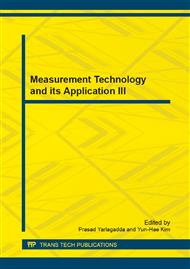p.189
p.193
p.198
p.203
p.208
p.212
p.218
p.223
p.227
Investigation on Spectral Aliasing Error Resulted from Truncating Signals Incoherently
Abstract:
The aliasing error resulted from truncating signals incoherently is one of main spectrum errors. The investigation on the error remains quite limited. This restricted the development of high accuracy spectrum analysis. This work discussed the truncation effect and the corresponding aliasing error in quantity, and revealed its dependence upon the truncation conditions. Then a concise technique was proposed to suppress the truncation aliasing error of DFT spectrum by modifying the first datum of the digital signal in time domain. Under general truncation conditions, the simulations show that the error correction of the 5 spectral lines near the main lobe is effective and the maximum absolute error of the main spectral line is decreased from ±2.4‰ to ±0.5‰.
Info:
Periodical:
Pages:
208-211
Citation:
Online since:
June 2014
Authors:
Keywords:
Price:
Сopyright:
© 2014 Trans Tech Publications Ltd. All Rights Reserved
Share:
Citation:


